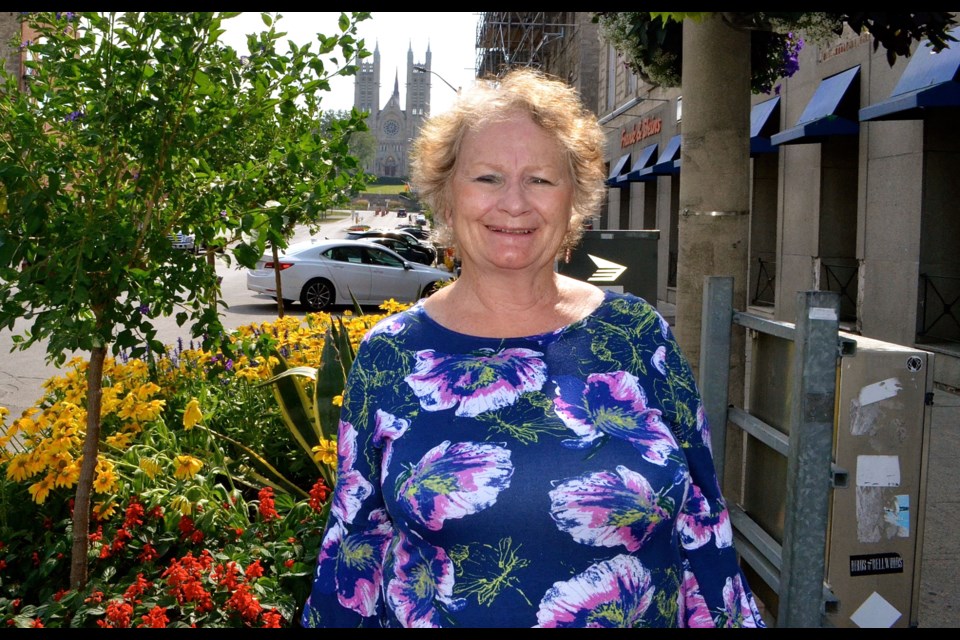Walking through downtown Guelph with Susan Ratcliffe, president of the Architectural Conservancy of Ontario Guelph & Wellington Branch can be an entertaining and educational experience.
“The ACO is provincial with 25 branches across Ontario,” said Ratcliffe. “Our mission is twofold, advocacy and education about heritage buildings and landscapes.”
Ratcliffe is very passionate about protecting the city’s cultural identity and can be a thorn in the side of developers and politicians hoping to fast track developments on heritage properties. She said preserving historical buildings and landscapes is often better for the overall environmental and economic health of the city.
“There is the environmental and efficient use of resources but it is also makes the city unique,” she said. “I’ve been attacked many times for talking about the geography of nowhere – the four banks on the corner kind of place and that is every city. The sense of place comes from the limestone heritage. It makes it our city.”
Ratcliffe was born in London, England, the oldest of two brothers and two sisters. She spent several years in university earning a BA in English and a B.Ed at the University of Toronto as well as an MA in English from the University of Waterloo. She spent most of her career as a high school English teacher.
“I started at Barrie Central High School then I was at Centennial CVI in Guelph and Erin District High School,” said Ratcliffe. “I was a teacher librarian and I still work part time at the Guelph Public Library as a reference librarian. I started there when I retired and I really enjoy it.”
Retirement hasn’t slowed her down especially when it comes to promoting literature and educating people about the things she loves. She is chair of the board of directors for the Eden Mills Writers’ Festival, a columnist and an environmental activist.
“I am also a tour guide for the Arts Council for the historical walking tours and site coordinator for Doors Open Guelph,” she said.
Ratcliffe’s advocacy for Guelph’s architectural heritage follows in the footsteps of people such as celebrated artist and historian Gordon Couling who died in 1984.
“The ACO Provincial started in 1933 and he started the Guelph branch in the mid 60s when a lot of demolition was taking place,” said Ratcliffe. “He was aiming to get the Heritage Act in place and get the LACAC the precursor to Heritage Guelph. Once that was done, he didn’t feel the need for the branch anymore.”
The Heritage Act of 1974 and the establishment of Local Architectural Advisory Committees slowed the demolition of heritage buildings across the province but developments in Guelph starting in 2003 raised new concerns among conservationists.
“We founded our branch in 2006,” said Ratcliffe. “I was the second president. It was during the efforts to protect the convent so, we formed to be involved in that.”
The Sisters of Loretto Convent built in 1857 was ultimately saved from the wrecker’s ball and repurposed in 2012 as the Guelph Civic Museum.
An example of private developers and conservationists working together is the award-winning restoration of the Petrie Building downtown on Wyndham Street built in 1882.
“The ACO raised $90,000 because we won a national prize and we got a donation from an anonymous source for $10,000,” said Ratcliffe.
The three-year restoration project led by Kirk Roberts and Peregrine Wood was completed in 2018 and the building has since attracted new businesses to the city such as Brothers Brewing Company, Sway Advertising and The Modern Bride.
“The Modern Bride came here to be in that building,” said Ratcliffe. “No other bridal shop has those features. You can take a picture with the basilica behind it through the huge 20-foot windows. That’s a place of business you can’t replicate.”
Ratcliffe said the beauty and structural integrity of old stone buildings are just a few of the factors we should consider.
“It’s environmental because one building equals 3 million pop cans,” she said. “So, you are putting all of that into landfill. Then it is replaced with mostly imported material. So, the environmental footprint is huge compared to adaptively reusing.”
A few of the ACO’s efforts of late include protecting barns and landscape features in the Clair-Maltby development on the city’s south end and preserving the sightlines of the basilica downtown.
“No other city has that vista,” she said. “You can’t replace that and you can’t rebuild it.”
She hopes that sharing stories of Guelph’s heritage buildings with everyone, especially young people, during her walks and workshops will help raise their value and ensure their survival.
“I love this city and I love the stories because they animate the whole thing,” she said. “Historian Ross Irwin told me once, ‘Susan, I’m the historian. I care about the facts. You’re the heritage person because you like to tell the stories.’”
.png;w=120;h=80;mode=crop)

